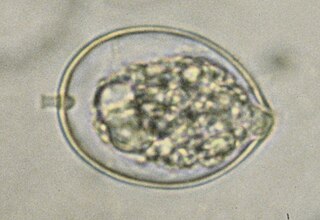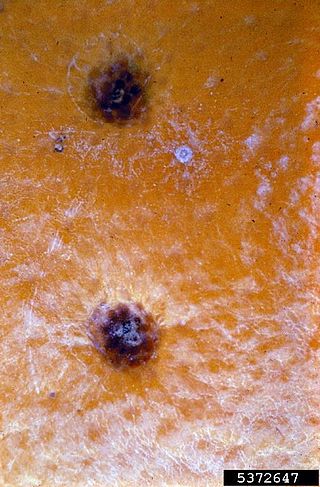
Fire blight, also written fireblight, is a contagious disease affecting apples, pears, and some other members of the family Rosaceae. It is a serious concern to apple and pear producers. Under optimal conditions, it can destroy an entire orchard in a single growing season.

Citrus production encompasses the production of citrus fruit, which are the highest-value fruit crop in terms of international trade. There are two main markets for citrus fruit:

Citrus greening disease is a disease of citrus caused by a vector-transmitted pathogen. The causative agents are motile bacteria, Liberibacter spp. The disease is transmitted by the Asian citrus psyllid, Diaphorina citri, and the African citrus psyllid, Trioza erytreae. It has no known cure. It is graft-transmissible.

Citrus canker is a disease affecting Citrus species caused by the bacterium Xanthomonas. Infection causes lesions on the leaves, stems, and fruit of citrus trees, including lime, oranges, and grapefruit. While not harmful to humans, canker significantly affects the vitality of citrus trees, causing leaves and fruit to drop prematurely; a fruit infected with canker is safe to eat, but too unsightly to be sold. Citrus canker is mainly a leaf-spotting and rind-blemishing disease, but when conditions are highly favorable, it can cause defoliation, shoot dieback, and fruit drop.

Xylella fastidiosa is an aerobic, Gram-negative bacterium of the genus Xylella. It is a plant pathogen, that grows in the water transport tissues of plants and is transmitted exclusively by xylem sap-feeding insects such as sharpshooters and spittlebugs. Many plant diseases are due to infections of X. fastidiosa, including bacterial leaf scorch, oleander leaf scorch, coffee leaf scorch (CLS), alfalfa dwarf, phony peach disease, and the economically important Pierce's disease of grapes (PD), olive quick decline syndrome (OQDS), and citrus variegated chlorosis (CVC). While the largest outbreaks of X. fastidiosa–related diseases have occurred in the Americas and Europe, this pathogen has also been found in Taiwan, Israel, and a few other countries worldwide.
Citrus tristeza virus (CTV) is a viral species of the genus Closterovirus that causes the most economically damaging disease to its namesake plant genus, Citrus. The disease has led to the death of millions of Citrus trees all over the world and has rendered millions of others useless for production. Farmers in Brazil and other South American countries gave it the name "tristeza", meaning sadness in Portuguese and Spanish, referring to the devastation produced by the disease in the 1930s. The virus is transmitted most efficiently by the brown citrus aphid.
Ulmus americana var. floridana, the Florida elm, first described as Ulmus floridana by Alvan Wentworth Chapman in the 1860s, is smaller than the type, and occurs naturally in north and central Florida south to Lake Okeechobee.

Phytophthora cactorum is a fungal-like plant pathogen belonging to the Oomycota phylum. It is the causal agent of root rot on rhododendron and many other species, as well as leather rot of strawberries.
Pestalotiopsis palmarum is the causative agent of a fungal disease of bananas, coconut and Date palms. The fungus causes leaf spots, petiole/rachis blights and sometimes bud rot of palms. Unlike other leaf spot and blight diseases, Pestalotiopsis palmarun attacks all parts of the leaf from the base to the tip. Whereas most diseases only infect the leaf blade or the leaf petiole.
Sphaceloma perseae is a plant-pathogenic fungus in the division Ascomycota. It infects the avocado plant, a tree native to Central America and Mexico. Currently there are three cultivars of avocados in large-scale agricultural production: Guatemalan, Mexican, and West Indian. The pathogen is currently limited to the P. Americana species but is able to infect all three cultivars. The resulting disease is known as avocado scab for the symptoms which are present on the fruit of the avocado tree. It is believed that the disease developed in Florida in the early twentieth century and is related to citrus scab, Elsinoe fawcetti. Since then, S.perseae has spread to many regions worldwide that support cultivation of the avocado tree. This pathogen threatens the global avocado market, including both importers and exporters of the crop. Countries which import avocados, including the United States, have experienced a rising demand over the past decade which is projected to continue for years to come. An understanding of avocado scab characteristics and feasible prevention methods is essential to maintenance of cultures and economies influenced by the avocado fruit.
Mal secco is a disease caused by the conidia-producing fungal plant pathogen Phoma tracheiphila. It mainly causes disease to citrus trees in the Mediterranean. In particular it causes damage to lemon trees in the Mediterranean basin. The plant pathogen, Phoma tracheiphila, is rain- and wind-disseminated.

Phytophthora kernoviae is a plant pathogen that mainly infects European beech and Rhododendron ponticum. It was first identified in 2003 in Cornwall, UK when scientists were surveying for the presence of Phytophthora ramorum. This made it the third new Phytophthora species to be found in the UK in a decade. It was named Phytophthora kernoviae after the ancient name for Cornwall, Kernow. It causes large stem lesions on beech and necrosis of stems and leaves of Rhododendron ponticum. It is self-fertile. It has also been isolated from Quercus robur and Liriodendron tulipifera. The original paper describing the species, stated it can infect Magnolia and Camellia species, Pieris formosa, Gevuina avellana, Michelia doltsopa and Quercus ilex. Since then many other plants have been identified as natural hosts of the pathogen. Molecular analysis has revealed that an infection on Pinus radiata, recorded in New Zealand in 1950, was caused by P. kernoviae. The pathogen was also noted on Drimys winteri, Gevuina avellana, Ilex aquifolium, Quercus ilex, Vaccinium myrtillus, Hedera helix, Podocarpus salignas.
Texas Phoenix palm decline, or lethal bronzing, is a plant disease caused by a phytoplasma, Candidatus Phytoplasma palmae. It takes its name from the state it was first identified in and the palm genus, Phoenix, upon which it was first identified. It is currently found in parts of Florida and Texas.

Cold-hardy citrus is citrus with increased frost tolerance and which may be cultivated far beyond traditional citrus growing regions. Citrus species and citrus hybrids typically described as cold-hardy generally display an ability to withstand wintertime temperatures below −5 to −10 °C. Cold-hardy citrus may be generally accepted 'true' species or hybrids involving various other citrus species. All citrus fruits are technically edible, though some have bitter flavors often regarded as unpleasant, and this variability is also seen in cold-hardy citrus fruits. Those listed as "inedible fresh" or "semi-edible" can be cooked to make marmalade.
Citrus exocortis is a disease of citrus plants, caused by the Citrus exocortis viroid. It can cause stunted growth and reduced yields in affected plants. The disease is also sometimes called "scalybutt". CEVd can also infect tomato plants. The resulting disease is sometimes called "tomato bunchy top disease".

Citrus black spot is a fungal disease caused by Phyllosticta citricarpa(previously known as Guignardia citricarpa). This Ascomycete fungus affects citrus plants throughout subtropical climates, causing a reduction in both fruit quantity and quality.
The foamy bark canker is a disease affecting oak trees in California caused by the fungus Geosmithia sp. #41 and spread by the Western oak bark beetle. This disease is only seen through the symbiosis of the bark beetles and the fungal pathogen. The bark beetles target oak trees and bore holes through the peridermal tissues, making tunnels within the phloem. The fungal spores are brought into these tunnels by the beetles and begin to colonize the damaged cells inside the tunnels. Symptoms of the developing fungus include wet discoloration seeping from the beetle entry holes as the fungus begins to consume phloem and likely other tissues. If bark is removed, necrosis of the phloem can be observed surrounding the entry hole(s). As the disease progresses, a reddish sap and foamy liquid oozes from entry holes, thus giving the disease the name foamy bark canker. Eventually, after the disease has progressed, the tree dies. This disease is important because of its detrimental effects on oak trees and its ability to spread to several new Californian counties in just a couple of years.
Citrus rootstock are plants used as rootstock for citrus plants. A rootstock plant must be compatible for scion grafting, and resistant to common threats, such as drought, frost, and common citrus diseases.
Citrumelo is also called Swingle citrumelo trifoliate hybrid, because it is cold hardy and is a hybrid between a 'Duncan' grapefruit and a trifoliate orange, developed by Walter Tennyson Swingle.
Cophinforma tumefaciens is an ascomycete fungus that is a plant pathogen infecting citruses, and other shrubs and trees.










